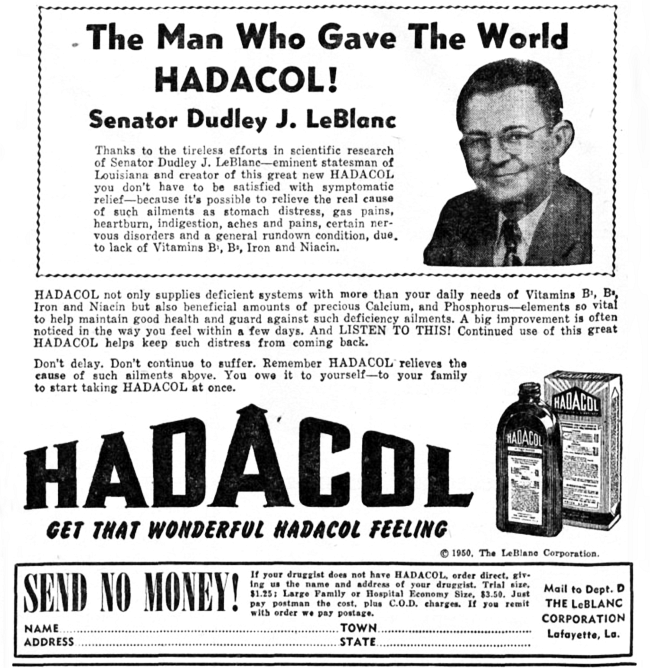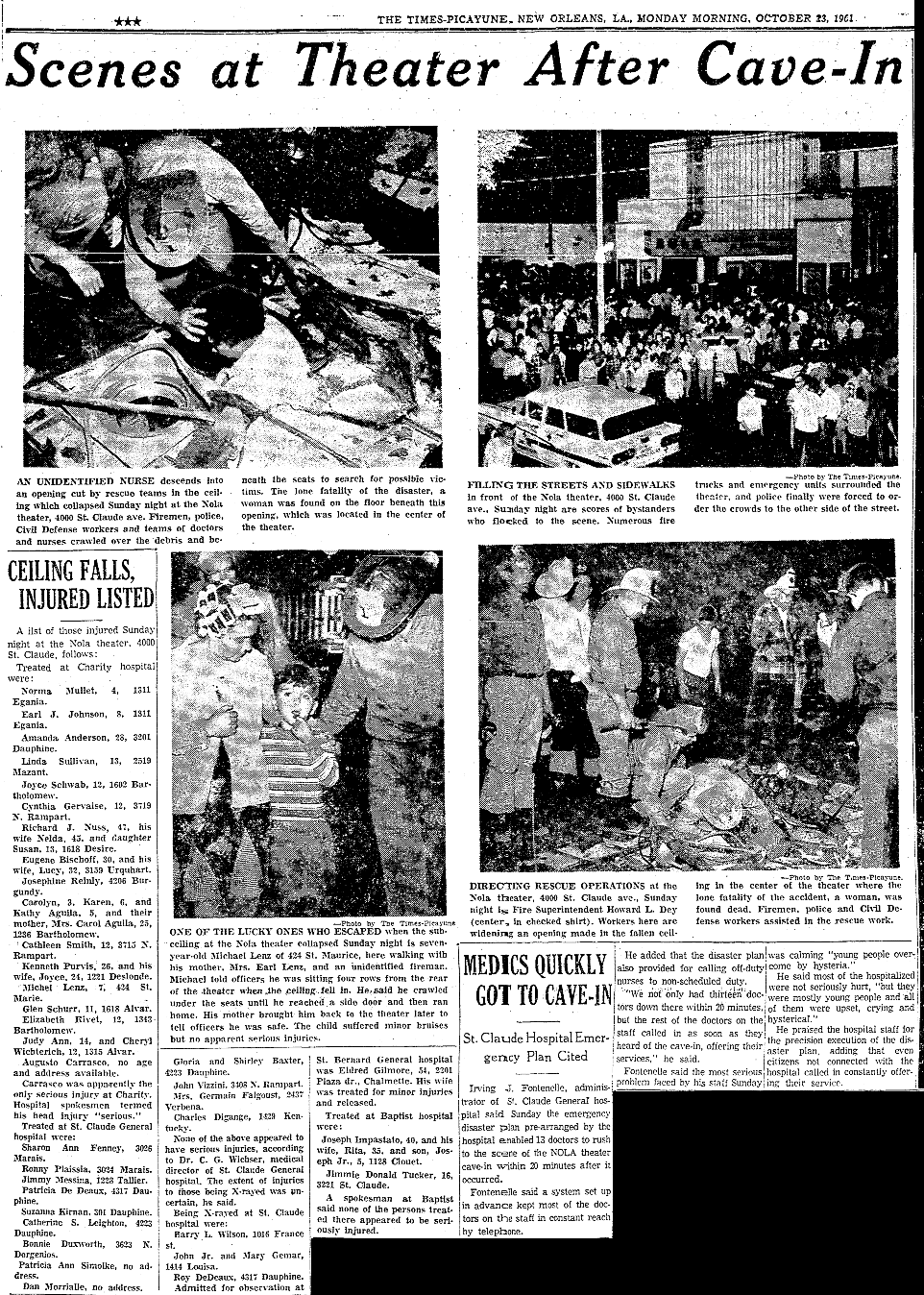|
October 22


Dudley Joseph LeBlanc,
Sr. Dies
October 22, 1971
1951 Advertisement Dudley Joseph LeBlanc, Sr., known as Coozan Dud LeBlanc, was a Democratic member
of the Louisiana Public Service Commission, a four term Louisiana State Senator, President
Pro Tempore of the Louisiana State Senate, and a candidate for governor. He
is considered by many to be the "father" of the Louisiana Old Age Pension program, which
began as $30 a month payment to individuals over 65. But LeBlanc is best remembered for his entrepreneurial talents which
netted him a fortune through the alcohol-laden patent medicine known as Hadacol. In 1943, LeBlanc conceived the idea that became "Hadacol" in New Orleans, when he had persistent
pain in his foot and elsewhere. He asked a doctor to give him medication for pain: then he found that what the doctor gave
him was a B-vitamin elixir, which he proposed to duplicate with a few changes and sell to a mass consumer market. On
a return visit, LeBlanc allegedly stole a bottle of the medicine when the nurse had left the room. LeBlanc said that
his research showed that multivitamins taken collectively would yield greater results than a single vitamin for
a specific problem. LeBlanc created the name "Hadacol"
from his former business, the Happy Day Company, maker of Happy Day Headache Powders (which had been seized by the Food
and Drug Administration) and Dixie Dew Cough Syrup. "Happy" became "HA", "Days" became "DA,"
"Company" became "CO", and his own last name "LeBlanc" provided the "L". He marketed
Hadaco as a vitamin supplement. Its principal attraction, however, was that it contained 12 percent alcohol (listed
on the tonic bottle's label as a "preservative"), which made it quite popular in the dry counties of the
south. Time magazine once described him as "a stem-winding
salesman who knows every razzle-dazzle switch in the pitchman's trade". For his "Hadacol Goodwill Caravan"
touring shows (the last of the big-time "medicine shows"), LeBlanc hired Hollywood celebrities, including Roy
Acuff, Milton Berle, Lucille Ball, Minnie Pearl, New Orleans' own Connee Boswell, Mickey Rooney, Bob
Hope, Cesar Romero, Dorothy Lamour, Carmen Miranda, George Burns and Gracie Allen, Judy
Garland, Jack Dempsey, Chico Marx, Hank Williams and James Cagney to market the product. He
also sponsored a separate touring show featuring notable Jazz and Blues musicians to attract black customers.
Admission to a Hadacol gala was two Hadacol boxtops for adults, one for children. Considering that the 8 ounce bottle cost
$1.25 and the "family size" 24 ounce bottle cost $3.50 each during the late 1940s, this was not cheap (Adjusted
for inflation, the prices would be around $10 and $30 in 2007). Sales of the tonic at the shows were brisk. In a 15-month period ending in March 1951, LeBlanc sold more than $3,600,000 worth of the tonic.
In another six months, after LeBlanc sold his interest of the LeBlanc Corporation (Hadacol's parent company) to investors
for $8,200,000. The enterprise collapsed with the discovery that LeBlanc had been spending more for advertising than
he was taking in as receipts (turning its $3,600,000 profit into a $1,800,000 second-quarter loss). He had concealed both
$2,000,000 in unpaid bills and a $656,151 tax debt and another $2,000,000, listed in the ledgers as "Accounts Receivable",
which were cases of the tonic out on consignment, much of which were being returned. In
an official court statement, the Federal Trade Commission stated that the publicity behind the tonic was "false,
misleading and deceptive" in representing it as as "an effective treatment and cure for scores of ailments
and diseases." In an official press release in 1951, the AMA stated, "It
is hoped that no doctor will be uncritical enough to join in the promotion of Hadacol. It is difficult to imagine how one
could do himself or his profession greater harm from the standpoint of the abuse of the trust of a patient suffering from
any condition. Hadacol is not a specific medication. It is not even a specific preventive measure." The ensuing bad publicity played a contributing factor to LeBlanc losing a gubernatorial election
in 1952 and effectively halting his future statewide electoral chances. In 1954, after the Hadacol fiasco, LeBlanc
tried to re-enter the patent medicine market with a lemon flavored non-alcoholic vitamin tonic named "Kary-On". Unlike
Hadacol, it quickly vanished from production. LeBlanc died in his hometown, Abbeville,
on October 22, 1971 at the age of 77. (Wiki)
Related reading:
Coozan
Dudley Leblanc pb: From Huey Long to Hadacol
Dudley
Leblanc: A Biography
Acadian
Miracle by Dudley J. Leblanc
The
true story of the Acadians by Dudley J. Leblanc
Republican Bobby Jindal was re-elected Governor of Louisiana on October 22, 2011.
The October 22,
1964 edition of Newsweek magazine reported that Mayor Victor H. Schiro "took refuge in an underground Civil Defense shelter"
during Hurricane Hilda. The water-tight structure now abandoned still remains on the neutral ground of West
End Boulevard near the lake.
Dillard University's library was built in 1961 and dedicated in honor of its first acting president,
the Rev. Will W. Alexander on October 22, 1961.
Nola Theater Ceiling Collapses
Sunday, October 22, 1961 1 Dead -- Many Injured
On Sunday, October 22, 1961 at 6:35
p.m., as young teenagers sat in their St. Claude neighborhood Nola Theater, the plaster ceiling collapsed onto them.
Built in 1941 at a cost of $25,000, the 400-seat theater had not been inspected since its construction -- no inspection was
required by law (unless a complaint was filed). Mayor Victor H. Schiro was quick to order periodic inspections of auditoriums
and theaters almost immediately after this event in which one life was lost and 50 were injured. This page from the Times-Picayune
the day after lists the injured. Those in the theater that evening
described a loud rumbling, sounding like drums, followed by the projection room wall collapsing, and finally an unbroken wave
of plaster, boards, insulation, and steel mesh falling from the rear of the theater to the screen. One thought a bomb
had exploded. Only four seats, in the rear, were untouched by building materials which had fallen some 35 feet from
the sub-ceiling. Darkness and dust enveloped the scene.
Dozens of ambulances were dispatched from Orleans, Jefferson, and St. Bernard parishes as well as from Jackson Barracks
and Callender Field. Thirteen doctors from St. Claude General Hospital rushed to the scene of the disaster -- 19 patients
from the theater were treated at St. Claude General. At Charity Hospital, 13 doctors and 6 nurses were called to await
the arrival 25 of injured patients. Twenty-five others were treated at Mercy and Baptist hospitals. Fifty firemen, fire-trucks,
30 police, emergency vehicles, 30 Civil Defence workers, 15 emergency crews from St. Bernard and Jefferson parishes, and four
priests arrived. K-9 corps kept back the gathering crowd outside. Traffic around the block of 4000 St. Claude
was re-routed. The uninjured audience of mostly young teen-age
girls, who had bought a ticket to watch "Homicidal", became hysterical and were issued sedatives by emergency
workers. Within 15 to 20 minutes all patrons had been evacuated from the theater. Mrs. Bertrand (Mary V.) Otinett,
65 years of age, who resided at 6535 Burgundy Street was found dead in center of the theater. Source: The Times-Picayune.
On Sunday, October 22, 1944 Louis "Satchmo" Armstrong and his Orchestra performed two shows at the
Rhythm Club, 3000 Jackson Avenue. Billed as "The Trumpet King" he played a 2:00 to 5:00 P.M. Matinee
(tickets $1) and for an evening show from 10 P.M. to 2 A.M. (tickets $1.25 advance, $1.50 at the door). Also featured
that evening was the Brown Skin Follies and "All-Star Studded Floor Show" according to the advertising poster.
Walter Stauffer McIlhenny, born on October 22, 1910, served as
president of McIlhenny Company, maker of Tabasco brand pepper sauce. Around 1940, when he began executive training
at the company at Avery Island. McIlhenny's grandfather, Edmund McIlhenny, had invented the fiery condiment, and his father,
John Avery McIlhenny, had presided over the company from 1890 to 1898. After sering with distinction in World War II, he returned
to the organization in 1946, assumed its presidency in 1949, and retained that office until his own death on June 22, 1985. During his tenure as head of the company, McIlhenny expanded
and modernized the production and marketing of Tabasco brand pepper sauce and helped to mold the brand into an international
culinary icon.
The Christian Science Monitor reported on October 22, 1909 "New Orleans
Prepares Welcome To President and Waterway Hosts". President William Howard Taft arrived in New
Orleans on October 30, 1909, aboard the flagship Oleander.
Robert Charles Davey, born in New Orleans on October 22, 1853, was elected to the
State senate in 1879, 1884, and again in 1892. He served as president pro tempore of the senate during the sessions of 1884
and 1886. He served as judge of the first recorder's court in New Orleans 1880-1888. He was an unsuccessful candidate for
mayor of New Orleans in 1888. Davey was elected as a Democrat to the Fifty-third Congress (March 4, 1893-March 3, 1895).
He declined to be a candidate for renomination in 1894. Davey was elected to the Fifty-fifth and to the five succeeding Congresses
and served from March 4, 1897, until his death. Had been reelected to the Sixty-first Congress, but died in New
Orleans on December 26, 1908, before the close of the Sixtieth Congress. He was interred in Metairie Cemetery. The
now defunct Robert C. Davey public school was named for him.
Louis Alfred Wiltz, born on October 22, 1843, served as 29th Governor of Louisiana from 1880 to 1881
and before that time was mayor of New Orleans, lieutenant governor of Louisiana, and a member
of the Louisiana House of Representatives. He died on October 16, 1881.
|








